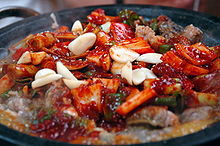Eptatretus
Eptatretus est un genre d'agnathes de la famille des Myxinidae (les myxines en français), des animaux aquatiques anguilliformes.
Liste d'espèces
[modifier | modifier le code]- Eptatretus bischoffii (en) (Schneider, 1880)
- Eptatretus burgeri (en) (Girard, 1855)
- Eptatretus caribbeaus Fernholm, 1982
- Eptatretus carlhubbsi McMillan et Wisner, 1984
- Eptatretus chinensis Kuo et Mok, 1994
- Eptatretus cirrhatus (Forster, 1801)
- Eptatretus deani (en) (Evermann et Goldsborough, 1907)
- Eptatretus decatrema Regan, 1912 (non reconnu par FishBase)
- Eptatretus eos Fernholm, 1991
- Eptatretus fernholmi McMillan et Wisner, 2004 (non reconnu par ITIS)
- Eptatretus fritzi Wisner et McMillan, 1990
- Eptatretus goliath Mincarone et Stewart, 2006 (non reconnu par ITIS)
- Eptatretus grouseri McMillan, 1999
- Eptatretus hexatrema (en) (Müller, 1836)
- Eptatretus indrambaryai Wongratana, 1983
- Eptatretus lakeside Mincarone et McCosker, 2004 (non reconnu par ITIS)
- Eptatretus laurahubbsae McMillan et Wisner, 1984
- Eptatretus longipinnis Strahan, 1975
- Eptatretus mcconnaugheyi Wisner et McMillan, 1990
- Eptatretus mccoskeri McMillan, 1999
- Eptatretus mendozai Hensley, 1985
- Eptatretus menezesi Mincarone, 2000
- Eptatretus minor (en) Fernholm et Hubbs, 1981
- Eptatretus multidens Fernholm et Hubbs, 1981
- Eptatretus nanii Wisner et McMillan, 1988
- Eptatretus octatrema (en) (Barnard, 1923)
- Eptatretus okinoseanus (Dean, 1904)
- Eptatretus polytrema (en) (Girard, 1855)
- Eptatretus profundus (en) (Barnard, 1923)
- Eptatretus sinus Wisner et McMillan, 1990
- Eptatretus springeri (Bigelow et Schroeder, 1952)
- Eptatretus stoutii (Lockington, 1878)

Eptatretus stoutii. - Eptatretus strahani McMillan et Wisner, 1984
- Eptatretus wayuu Mok, Saavedra-Diaz et Acero P., 2001
- Eptatretus wisneri McMillan, 1999
- Eptatretus aceroi Fernández et Fernholm, 2014[4]
- Eptatretus alastairi Mincarone et Fernholm, 2010
- Eptatretus ancon Mok et al., 2001
- Eptatretus astrolabium Fernholm et Mincarone, 2010
- Eptatretus atami Dean, 1904
- Eptatretus bobwisneri Fernholm et al., 2013[5]
- Eptatretus cheni Shen et Tao, 1975
- Eptatretus cryptus Roberts et Stewart, 2015[6]
- Eptatretus gomoni Mincarone et Fernholm, 2010
- Eptatetrus goslinei Mincarone et al., 2021
- Eptatretus luzonicus Fernholm et al., 2013[5]
- Eptatretus moki McMillan et al., 2004
- Eptatretus nelsoni Kuo et al., 1994
- Eptatretus poicilus Zintzen et Roberts, 2015[6]
- Eptatretus sheni Kuo et al., 1994
- Eptatretus strickrotti (en) Møller et Jones, 2007
- Eptatretus taiwanae Shen et Tao, 1975
- Eptatretus walkeri McMillan et Wisner, 2004
- Eptatretus yangi Teng, 1958
Génétique
[modifier | modifier le code]Les génomes de deux espèces ont été séquencés, d'E. burgeri (en) et d'E. atami. Il a fallu le faire sur les cellules sexuelles car chez ces animaux les divisions cellulaires s'accompagnent d'un réarrangement par élimination de chromosomes. Ces études montrent qu'un ancêtre commun des Cyclostomes (myxines et lamproies) a subi une triplication de son génome, après la duplication commune à tous les Vertébrés. Elles confirment par ailleurs l'hypothèse 2R selon laquelle un ancêtre commun des Gnathostomes (les Vertébrés à mâchoire) a subi une seconde duplication (elle est absente chez les Cyclostomes)[7].
Usages
[modifier | modifier le code]
Dans la plupart des pays les myxines ne sont généralement pas consommées, mais la Myxine côtière (Eptatretus burgeri (en)) est appréciée comme aliment dans la péninsule coréenne ( 꼼장어 / kkomjangeo, dans le plat appelé 꼼장어 볶음 / kkomjangeo bokkeum) et par les Coréens du Japon. Elle l'est également par les Japonais de certaines régions, notamment les préfectures de Nagasaki et de Niigata.
Notes et références
[modifier | modifier le code]- (en) Cet article est partiellement ou en totalité issu de l’article de Wikipédia en anglais intitulé « Eptatretus » (voir la liste des auteurs).
- ↑ (en) R. Froese et D. Pauly, « Petromyzontidae », sur FishBase version (02/2017), .
- ↑ (en) Richard Van Der Laan, William N. Eschmeyer et Ronald Fricke, « Family-group names of Recent fishes », Zootaxa, vol. 3882, no 1, , p. 1–230 (DOI 10.11646/zootaxa.3882.1.1).
- ↑ (en) M M Mincarone, D Plachetzki, C L McCord, T M Winegard, B Fernholm, C J Gonzalez et D S Fudge, « Review of the hagfishes (Myxinidae) from the Galapagos Islands, with descriptions of four new species and their phylogenetic relationships », Zoological Journal of the Linnean Society, vol. 192, no 2, , p. 453–474 (ISSN 0024-4082, DOI 10.1093/zoolinnean/zlaa178).
- ↑ (en) Polanco Fernandez, A. & Fernholm, B. (2014): A New Species of Hagfish (Myxinidae: Eptatretus) from the Colombian Caribbean. Copeia, 2014 (3): 530–533.
- (en) Fernholm, B., Norén, M., Kullander, S.O., Quattrini, A.M., Zintzen, V., Roberts, C.D., Mok, H.-K. & Kuo, C.-H. (2013): Hagfish phylogeny and taxonomy, with description of the new genus Rubicundus (Craniata, Myxinidae). Journal of Zoological Systematics and Evolutionary Research, 51 (4): 296–307.
- (en) Zintzen, V., Roberts, C.D., Shepherd, L., Stewart, A.L., Struthers, C.D., Anderson, M.J., McVeagh, M., Noren, M. & Fernholm, B. (2015): Review and phylogeny of the New Zealand hagfishes (Myxiniformes: Myxinidae), with a description of three new species. Zoological Journal of the Linnean Society, 174 (2): 363–393.
- ↑ Hervé Le Guyader, « Le double effet du génome de la myxine », Pour la science, no 559, , p. 92-94 (présentation en ligne, lire en ligne
 [PDF], consulté le ).
[PDF], consulté le ).
Voir aussi
[modifier | modifier le code]Liens externes
[modifier | modifier le code]- (en) Tree of Life Web Project : Eptatretus
- (en) FishBase :
- (fr + en) ITIS : Eptatretus Cloquet, 1819
- (en) Animal Diversity Web : Eptatretus
- (en) NCBI : Eptatretus (taxons inclus)

